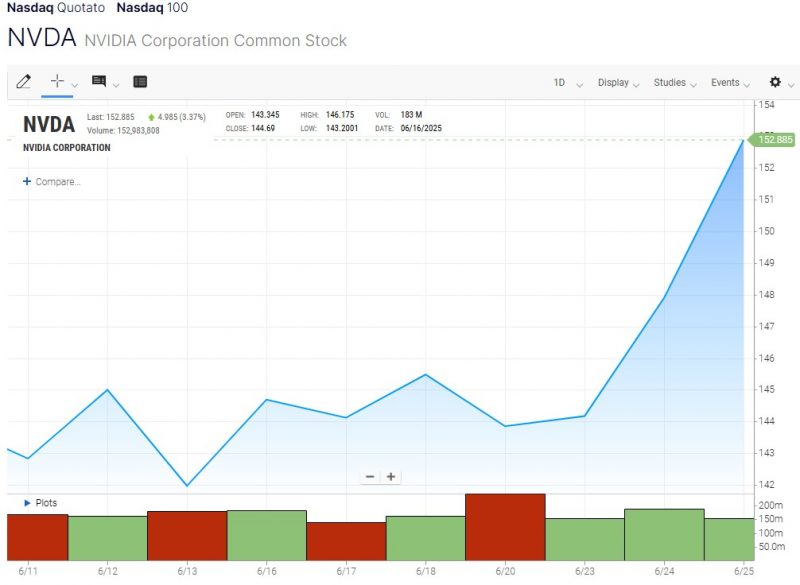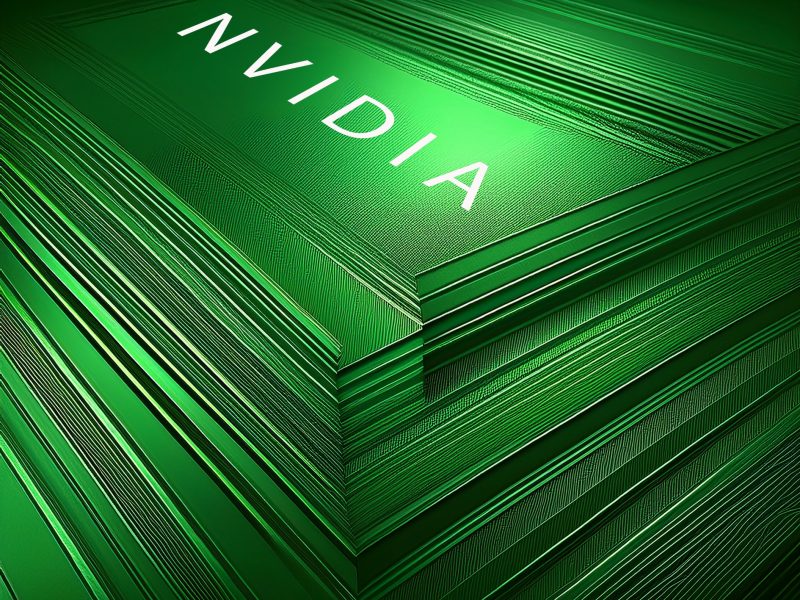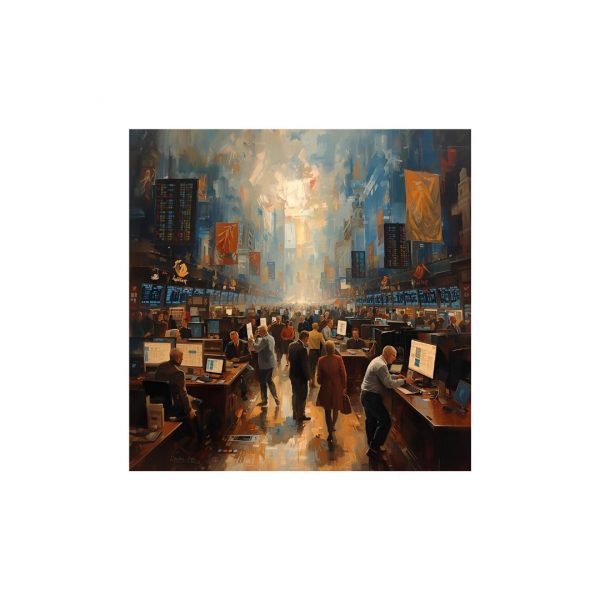Company Analysis of NVIDIA Inc. (NVDA) – Understanding the Heartbeat of AI, its Ecosystem, and Future Prospects
Introduction: The Heartbeat of AI – The Empire of NVIDIA Corporation
While the name NVIDIA once primarily brought to mind cutting-edge graphics cards for video games, today the landscape has radically changed. The Santa Clara-based company has transformed into the true heartbeat of artificial intelligence, a technological giant whose innovation is shaping the future of computing in sectors far beyond gaming. Its GPUs (Graphics Processing Units) are no longer just tools for immersive gaming experiences, but have become the essential infrastructure upon which the AI revolution is built, from machine learning to data centers, from robotics to autonomous vehicles. This analysis of NVIDIA shares aims to explore the company’s evolution, its business model, its dominant market position, and the future prospects that make it such a crucial player in the global technological investment landscape. Understanding the analysis of NVIDIA shares and its corporate strategy is essential for anyone looking to invest in an entity that not only dictates trends but profoundly influences how we live and interact with technology.
Understanding the Company in Our Stock Analysis of NVIDIA
NVIDIA Inc. is a multinational technology company based in Santa Clara, California, widely recognized as the pioneer of the GPU (Graphics Processing Unit) in 1999. What started as an innovation for enhancing 3D graphics in gaming has evolved into the bedrock of high-performance computing, artificial intelligence, and accelerated data processing. Today, NVIDIA is far more than just a chipmaker; it’s a platform company that provides comprehensive solutions encompassing hardware, software, and services, driving innovation across diverse industries.
As a prominent member of the “Magnificent Seven” tech giants, NVIDIA holds a unique and increasingly critical position in the global economy. Its shares are traded on the Nasdaq under the ticker NVDA, and they have become some of the most closely watched and actively traded assets for investors worldwide. The company’s exceptional growth, particularly in the wake of the AI boom, has propelled its market capitalization to unprecedented levels, making it one of the most valuable corporations globally. For many, investing in NVDA shares doesn’t just mean owning a piece of a tech company; it means gaining exposure to the fundamental technology powering the next industrial revolution.
When Was it Born? Analysis of NVIDIA . A Story of Vision, Evolution, and AI Dominance
NVIDIA’s story is that of a company which, despite having relatively recent roots compared to other tech giants, has managed to anticipate and shape entire computing revolutions.
- The Origins and the Birth of the GPU (1993-1999): NVIDIA Corporation was founded on April 5, 1993, by Jensen Huang (current CEO), Chris Malachowsky, and Curtis Priem. Their initial vision was clear: to create technology that would revolutionize 3D gaming. After years of research and development, the real turning point came in 1999 with the introduction of the GeForce 256, the first true Graphics Processing Unit (GPU), a chip specifically designed to process graphics. This event not only ushered in the modern era of video games but also laid the groundwork for NVIDIA’s future role.
- Expansion into Gaming and Beyond (2000-2010): With the dawn of the new millennium, NVIDIA consolidated its leadership in the PC graphics card market, becoming a household name for gamers. However, the company began to look beyond just gaming, recognizing the potential of its GPUs for parallel computing tasks. The CUDA (Compute Unified Device Architecture) platform, launched in 2006, was a fundamental step: it allowed developers to use the processing power of GPUs for scientific, engineering, and artificial intelligence applications.
- The AI Era and Data Center Dominance (2011-Today): This is the period when NVIDIA’s vision proved prophetic. The need to process enormous amounts of data for machine learning and artificial intelligence found the ideal solution in GPUs, thanks to their ability to perform thousands of calculations simultaneously. NVIDIA strategically shifted its focus towards the Data Center segment, which became its main growth engine. Its architectures like Volta, Ampere, and Hopper, along with software and development ecosystems (such as NVIDIA AI Enterprise), cemented its position as an almost irreplaceable provider for global AI infrastructure. Simultaneously, the company expanded its presence in emerging sectors like autonomous vehicles and robotics, always relying on the power of accelerated computing.
What Does NVIDIA Inc. Do? The Accelerated Computing Ecosystem
NVIDIA operates through a business model that focuses on designing Graphics Processing Units (GPUs) and chips for accelerated computing, but its true strength lies in the comprehensive ecosystem it has built around the hardware, including software, platforms, and services. This ecosystem serves various market segments, each crucial for its growth and the position of NVDA shares:
- Data Center: This segment is the primary driver of NVIDIA’s growth and profitability. It provides GPUs (such as the A100 and H100 series based on architectures like Hopper and Blackwell), network interconnects (Mellanox), artificial intelligence software (CUDA, NVIDIA AI Enterprise, Riva, NeMo), and complete systems (like DGX). Customers include large cloud companies, research centers, and enterprises that develop and deploy large-scale AI applications, from training complex language models to scientific simulation.
- Gaming: NVIDIA’s historical segment, where the company continues to dominate with its GeForce graphics cards (like the RTX series). These GPUs offer exceptional performance for video games, supporting advanced technologies such as ray tracing and DLSS (Deep Learning Super Sampling). Although the data center segment has surpassed gaming in terms of revenue, this segment remains a stable source of income and a driver for technological innovation that often extends to other areas.
- Professional Visualization: This segment targets professionals who require extremely high-fidelity graphics and computing power for activities such as computer-aided design (CAD), digital content creation, architectural visualization, and complex simulations. NVIDIA Quadro professional GPUs and the Omniverse platform (for creating and simulating interconnected virtual worlds) are the flagship products here.
- Automotive: NVIDIA is becoming a key player in the automotive sector, providing high-performance computing platforms for autonomous vehicles and next-generation infotainment. The NVIDIA DRIVE platform (with processors like Orin and Thor) is designed to manage the perception, planning, and control necessary for autonomous driving. Although this segment is still relatively small in terms of revenue, it represents an important area of future growth.
The integration of cutting-edge hardware with robust software and a vast developer ecosystem (supported by CUDA) is what makes NVIDIA an undisputed leader, especially in the field of artificial intelligence.
The Historical Performance In Our Analysis of NVIDIA
This analysis of NVIDIA show the evolution of NVIDIA (NVDA) shares is one of the most impressive success stories in the modern stock market, characterized by explosive growth, particularly in the last decade.
- NVIDIA IPO (1999): NVIDIA became a publicly traded company on January 22, 1999, with an initial public offering (IPO) price of $12 per share. Initially, its valuation reflected expectations for a company focused on 3D gaming, a rapidly expanding sector.
- Exponential Growth and Reorientation to AI: After its IPO, NVIDIA’s growth was consistent, but it was with the advent and acceleration of artificial intelligence (AI) that the stock experienced a true surge. The recognition that GPUs, originally designed for graphics, were incredibly efficient for the parallel computing workloads required by AI, radically transformed the company’s perception and valuation. Its Data Center segment became the primary driver of revenue growth, surpassing Gaming in strategic importance.
- Stock Splits for Greater Accessibility: To make its shares more accessible to a wider number of investors and increase liquidity, NVIDIA has carried out several stock splits throughout its history, the most recent and significant in July 2021 (a 4-for-1) and before that, in September 2007 (a 3-for-2) and multiple times prior. These splits multiplied the number of shares outstanding, proportionately reducing the price per share without altering the overall investment value for shareholders.
- Dividends and Buybacks: NVIDIA has historically offered a dividend, although often with a modest yield due to the rapid growth of its share price. The company has also implemented share repurchase programs (buybacks), returning value to shareholders and helping to support the stock price. These policies reflect the company’s financial strength and its confidence in its future prospects.
The performance of NVDA shares is a clear example of how a farsighted strategic vision and constant innovation can translate into enormous value creation for shareholders.
Analysis of NVIDIA : Simulation of Potential Investor Gain (Hypothetical Example):
To illustrate NVIDIA’s extraordinary ability to generate value for its shareholders, let’s consider a purely indicative example, based on historical data and stock splits:
Hypothetical Scenario: Imagine an investor purchased 1 share of NVIDIA (NVDA) at the IPO price of $12 on January 22, 1999.
Analysis of Stock Splits and Accumulated Shares: Since its listing, NVIDIA has performed several significant stock splits. Let’s consider the main ones to understand the multiplication of shares:
- 3-for-2 in September 2007 (every 1 share becomes 1.5)
- 4-for-1 in July 2021 (every 1 share becomes 4)
Applying these splits to the initial share: 1 share (IPO) → 1.5 shares (after 2007 split) → 6 shares (after 2021 split, because 1.5 * 4 = 6)
Final Number of Shares: That single original $12 share would have turned into approximately 6 shares today.
Current Value (Hypothetical): If we consider a price per share of approximately $120 (hypothetical value as of mid-June 2025, post-split), the total value of those 6 shares would be about $720 (6 shares * $120/share).
Capital Gain: Compared to the initial investment of $12, the capital gain would have been $708.
Percentage Return: This equates to a return of approximately 5,900% on the initial capital in just over 26 years, not counting any distributed dividends.
Important: This Analysis of NVIDIA’s ability to generate significant long-term value for its shareholders. It is crucial to remember that past performance is not indicative of future results, and the value of investments can go up or down.

Competitive Advantages of NVIDIA: Key Elements for Your Analysis of NVIDIA Shares
Beyond the numbers and well-known products, NVIDIA’s true value lies in some deep and often underestimated competitive advantages, which are crucial for anyone evaluating NVDA shares:
- The CUDA Ecosystem and Developer “Lock-in”: CUDA (Compute Unified Device Architecture) is not just a technology; it’s an entire proprietary software development platform from NVIDIA. It has enabled millions of developers, researchers, and scientists to program NVIDIA GPUs for a wide range of applications, from AI to simulation. This creates a powerful “lock-in” effect: switching platforms (and hardware) to a competitor would mean rewriting years of code and investments, making the transition extremely costly and complex. This ecosystem is an almost unassailable competitive moat.
- Leadership in Designing AI-Specific Chips: NVIDIA isn’t just producing generic GPUs. It’s at the forefront of designing highly specialized chips (like Hopper and Blackwell architectures, and H100/B200 chips) specifically optimized for training and inference of large-scale artificial intelligence models. This specialization gives it a significant advantage in terms of performance and energy efficiency compared to more generic solutions or attempts by competitors.
- The Vision of “Accelerated Computing” as a Service: NVIDIA doesn’t just sell chips; it sells the idea of “accelerated computing” as a fundamental infrastructure. It’s developing offerings like NVIDIA AI Foundry (for creating custom AI models) and the Omniverse platform (for creating virtual worlds and digital twins). This shifts the company from a pure hardware sales model to one that includes software, services, and complete solutions, generating more diversified and stable revenue streams.
- Dominance in the Data Center Segment: Although NVIDIA originated in gaming, its true economic engine has become the Data Center segment. Here, it competes not just on hardware performance, but on the complete integration between GPUs, high-speed network interconnects (thanks to the Mellanox acquisition), and a vast software stack. This allows it to offer end-to-end solutions that few others can match, making it an indispensable partner for cloud and AI giants.
- Execution Capability and Constant R&D: NVIDIA heavily reinvests in research and development (R&D). Its ability to constantly innovate and bring cutting-edge products to market with rapid cycles is crucial. This agility and long-term vision ensure the company stays a step ahead of the competition, maintaining its technological advantage.
Risks (Important Analysis of NVIDIA Shares):
Despite its dominant position, NVIDIA operates in a highly technology-intensive and competitive sector, which exposes it to various risks that every investor in NVDA shares should consider:
- Intense Competition: Even though NVIDIA is a leader, competition is fierce. Giants like Intel (INTC) and AMD (AMD) are direct rivals in the CPU and GPU segments, and they are investing heavily to catch up in AI. Furthermore, large tech companies like Google (Alphabet), Amazon (AWS), and Microsoft (Azure) are developing their own AI chips (ASICs), potentially reducing their dependence on NVIDIA’s solutions in the long term.
- Cyclicality of the Semiconductor Industry: The chip market is notoriously cyclical. Demand can fluctuate significantly due to macroeconomic factors, excess inventory, slowdowns in corporate spending, or declines in the gaming sector. An over-reliance on AI spending, if it were to slow down, could negatively impact.
- Geopolitical Tensions and Supply Chain Disruptions: NVIDIA is heavily reliant on Taiwan Semiconductor Manufacturing Company (TSMC) for the production of its advanced chips. Geopolitical tensions between China and Taiwan represent a significant risk to supply. Any disruption in the global semiconductor supply chain could have direct repercussions on NVIDIA’s ability to meet demand.
- Regulatory and Antitrust Risk: Given its near-monopolistic position in some segments of AI and accelerated computing (thanks primarily to CUDA), NVIDIA could face increasing scrutiny from global antitrust authorities. This could lead to investigations, fines, or restrictions on its business practices.
- Dependence on the CUDA Ecosystem: While CUDA is a huge competitive advantage, it is also a “single point of failure” if a competitor were to create an equally effective and universally adopted platform, or if the industry decided to standardize on an open-source alternative.
- Rapid Technological Evolution: The AI sector is constantly and rapidly evolving. NVIDIA must maintain an incessant pace of innovation to stay at the forefront. A misstep or delay in introducing new architectures or technologies could erode its competitive advantage.
Analysis of NVIDIA What Want to Do in the Future? Vision and Strategic Directions
NVIDIA is not a company that rests on its laurels; on the contrary, it is constantly looking to the future, investing heavily in research and development to maintain its leadership and open up new markets. Its strategic vision is crucial for understanding the long-term potential of NVDA shares.
- Continued Dominance in AI and Accelerated Computing: NVIDIA aims to further strengthen its position as the undisputed leader in AI. This translates into the continuous development of increasingly powerful GPUs (such as Blackwell and, in the future, Rubin architectures), advanced AI software platforms (like the CUDA ecosystem, NVIDIA AI Enterprise, NIMs), and integrated systems (like DGX servers and MGX solutions). The goal is to support the training and inference of increasingly complex AI models, from large language models (LLMs) to robotics.
- Expansion into the Enterprise Market: Beyond cloud giants, NVIDIA is aiming to expand its presence in the enterprise market. Many companies are, in fact, looking to integrate AI into their operations, and NVIDIA offers the end-to-end solutions (hardware and software) necessary to implement AI “in-house” or in hybrid environments. This includes generative AI, industrial robotics, and simulation for product design.
- The Metaverse and “Digital Twins” with Omniverse: NVIDIA envisions a future where the physical and digital worlds merge. The Omniverse platform is at the heart of this vision, enabling the creation of “digital twins” of factories, cities, or entire processes. This allows for extremely accurate simulations for optimization, training, and development. It is a long-term investment area with enormous potential in sectors like manufacturing, logistics, and architecture.
- Growth in the Automotive and Robotics Sectors: The Automotive segment, while still a small part of total revenue, is a crucial long-term bet. NVIDIA DRIVE platforms are becoming the standard for developing autonomous vehicles and advanced driver-assistance systems (ADAS). The company is also expanding its technology for robotic and autonomous applications across various sectors, from logistics to healthcare.
- Sovereign Computing and AI Security: With increasing geopolitical concerns and the growing importance of AI, many countries are investing in “sovereign computing” infrastructure, i.e., national AI data centers. NVIDIA is positioning itself as a key partner in these projects, offering solutions that allow governments and businesses to maintain control over their data and AI.
NVIDIA’s ability to anticipate market needs, invest heavily in R&D, and build software ecosystems around its hardware positions it to continue riding the wave of the AI revolution for decades to come.
Conclusion Of Analysis of NVIDIA – The Unstoppable Engine of the AI Era
The analysis of NVIDIA Inc. (NVDA) reveals a company that has gone far beyond its gaming legacy to become the fundamental pillar of the artificial intelligence era. Its dominant position in the Data Center segment, powered by cutting-edge GPUs and the incomparable CUDA ecosystem, makes it an almost irreplaceable provider for the growth and implementation of AI globally.
NVIDIA doesn’t just sell hardware; it sells an entire platform of accelerated computing, software, and services that create strong technological “lock-in” and competitive advantages difficult to emulate. Although it operates in a sector with fierce competition and geopolitical risks related to the supply chain, its strategic vision, massive R&D investments, and ability to anticipate market trends position it for sustained growth.
As is possible to understand from the Analysis of NVIDIA shares for an investor, NVIDIA offer direct and deep exposure to the AI revolution, the metaverse, and autonomous vehicles. It is a company that continues to define the future of technology. Like any investment, it carries risks, but its undisputed leadership and robust ecosystem suggest that NVIDIA will remain a crucial player and a potential generator of significant value in the global stock landscape for years to come.






